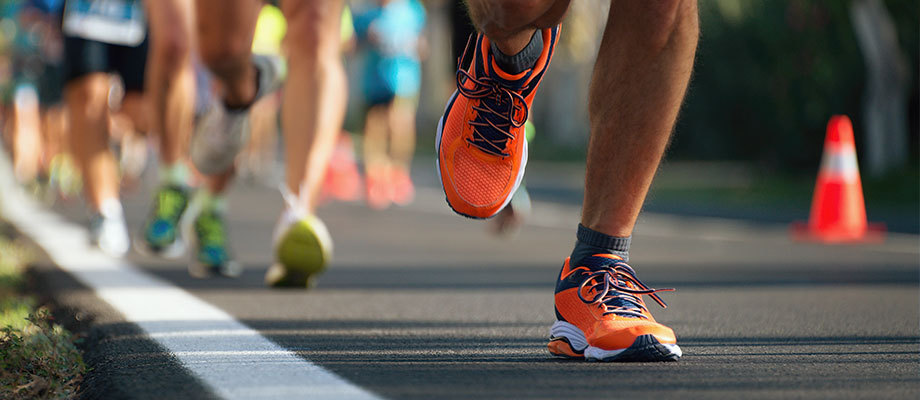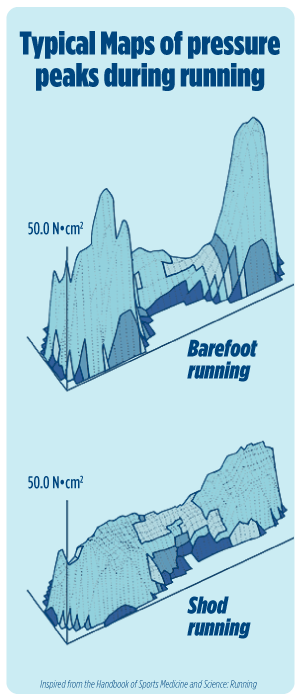
Runners looking to enhance their skill and reduce their risk of injury have some difficult decisions to make. After all, up to 79% of distance runners experience one injury or more per year, based on a literature review published in the British Journal of Sports Medicine. From training regimens to the proper footwear, it’s tricky navigating best practices for what may easily be the world’s most accessible sport.
Shoes are especially noteworthy. Different types of running require specific footwear, and the wrong choice can undermine performance and health. How should runners proceed? There’s no clear-cut answer due to the ongoing state of scientific research on the topic.
This article explores the strengths and weaknesses for the different types of running. Note that runners should always consult their doctor for advice on exercise regimen and proper footwear.
Types of Running
There are three major types of running: traditional, barefoot, and minimalist running.
Traditional Running
Traditional or shod running uses traditional running shoes during exercise.
According to John Hawley in the “Handbook of Sports Medicine and Science: Running,” pressure maps reveal how well shoes reduce pressure under the metatarsal heads, though there are large differences between different shoes. “Pressure maps have also shown that different shoe models can alter foot mechanics, which may lead to either the relief of pain, the onset of pain or overuse injuries. Consequently, runners must exercise great care in choosing footwear that address their individual performance and protection needs.”

Those needs can vary based on the individual and his or her training regimen. For instance, the body will experience additional strain during downhill running, running at faster speeds, and running on uneven surfaces like grass. Hence, the role of footwear takes on more importance. A lack of cushioning is a primary causative factor in stress fracture, degenerative joint injuries, and low back pain, Hawley noted.
Quality running shoes can help reduce the risk of injury by lessening shock the body experiences when it makes contact with the ground.
Barefoot Running
Barefoot running either uses no shoes or shoes that mimic such an experience. Note that sometimes barefoot and minimalist running are referred to interchangeably.
Runners who wear traditional shoes often hit the ground first with their heel, which is called a heel strike. That’s because there’s plenty of cushioning on that part of the shoe. Proponents of barefoot running claim, however, that it’s better for runners to land towards the center of the foot, which is called a forefront strike. Barefoot running promotes a forefront strike.
Such claims have support in research. A study from the British Journal of Sports Medicine, found that barefoot running can reduce stress on the knees and lessen shock absorption on the body. Another study in Medicine and Science in Sports and Exercise found that runners who used the heel strike had 2.7 times more moderate and severe injuries than those who used a forefoot strike.
There are potential drawbacks to barefoot running, however. As the National Center for Health Research found in several studies, forefoot strike running adds to the load experienced by the feet, ankles, Achilles tendons, and calf muscles. Barefoot running can lead to more lower body injuries, especially if runners fail to follow a training period for transitioning to this type of running.
While there is a correlation between barefoot running and a reduction in injury, the wealth of studies conducted in recent years has not provided definitive evidence to support or refute a direct connection. As Peter Walton and David French summarized in the British Journal of Health Psychology, there’s little consensus regarding the advantages or disadvantages of barefoot running compared to different types of running.
Minimalist Running
Minimalist running attempts to bridge the gap between conventional and barefoot running. A barefoot running experience is the goal, but shoes offer some protection and cushioning.
The proposed advantages of minimal running shoes are similar to that of barefoot shoe advocates. However, according to The Journal of Injury, Function and Rehabilitation, “There is mixed evidence regarding the kinematics and kinetics of minimally shod running compared with true barefoot running, and it is unclear whether minimally shod running mimics running barefoot.” The article cited studies and trials that conflicted each other in terms of the benefits and drawbacks of minimalist running. That takeaway is similar to Walton and French’s summary of the research on the three different types of running: There’s no consensus on the advantages and disadvantages for any running type.

One promising study for minimalist running followed 50 male runners who integrated minimalist shoes for up to 35% of their weekly training for six weeks. At that point, researchers in the European Journal of Sport Science found that the group improved their running performance and economy more than the group wearing only conventional shoes. The group of minimalist runners increased their use of those shoes to 100% of weekly training for 20 weeks, and no further benefits were found. The study may hint at positive implications for runners who integrate minimalist shoes for some part of their training regimen. Additional and larger studies would need to be conducted to verify those findings.
Enhancing Running Performance
Footwear can provide an opportunity for runners to enhance their performance and limit their injury risk. However, the topic is still relatively new, and more research is needed to examine how conventional, barefoot, and minimalist options impact foot mechanics and stress on the body. Runners also need to consider how their individual differences and training needs come into play.
Learn how you can improve athletic performances in your clients by earning your online MS in Exercise Science. You’ll receive a strong foundation in topics like exercise physiology, sports nutrition, and sports psychology. Aurora University’s program offers two specializations in sports performance and clinical exercise, and through additional coursework and an internship or capstone experience, you’ll be prepared for either of the following industry-leading certification exams:
- The American College of Sports Medicine’s (ACSM) Clinical Exercise Physiologist (CEP) exam.
- The National Strength and Conditioning Association’s (NSCA) Certified Strength and Conditioning Specialist (CSCS) exam.
All courses in the degree feature expert instructors with extensive experience in their fields.







